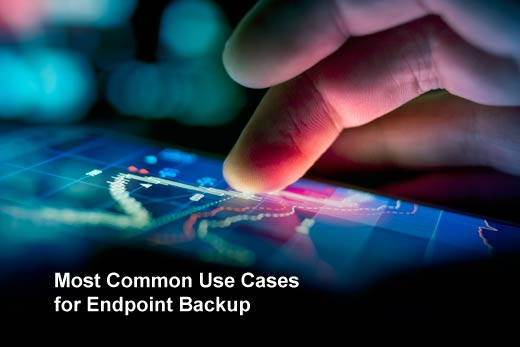Endpoint data protection and security are a bigger priority for enterprises as they consider the devastating impact of data loss. In fact, an ESG Research survey discovered that 66 percent of organizations have re-evaluated their endpoint security policies, processes and tools to create a plan for improving endpoint security. An integral part of the puzzle is endpoint backup, which companies are increasingly tapping as a core element of an overall endpoint security strategy.
In this slideshow, Code42 highlights the top five scenarios when endpoint backup staves off major data security threats in the enterprise.
Most Common Use Cases for Endpoint Backup
Click through for the top five scenarios where endpoint backup helps organizations mitigate major security threats and potential data loss, as identified by Code42.
Ransomware – Pay Up
Ransomware is malware that spreads via email attachments and locks users out of their computers until they pay a ransom. Ransomware is a growing problem in the enterprise; just last year, the CryptoLocker virus infected more than 200,000 computers, causing massive amounts of lost and unrecovered data. Even so, less than 2 percent of CryptoLocker-infected organizations go through the hassle and expense of paying the ransom. Unless the affected company has proper endpoint backup in place, it either pays the costly fee or risks never seeing its data again.
When Disaster Strikes
Allianz’s Top Business Risks of 2015 Report points to natural catastrophes as the second most feared business risk. In order to keep companies up and running (and earthquake-proof), endpoint backup protects employee data (living on the edge, outside the data center) in the cloud to ensure fast and easy recovery.
Hardware Failure
With 14,000 hard drives crashing every week, employees need assurance they can get to their data should the unthinkable happen. So they don’t skip a beat, companies should provide employees with seamless, self-restore capabilities via web or mobile devices.
Oops, Where Did It Go?
We’ve all done it – accidentally deleted a file. According to Aberdeen Group’s data loss report, out of respondents who had lost data, 47 percent experienced the loss due to an end user’s accidental deletion. Having an endpoint backup solution with automatic and continuous protection allows users to easily navigate back to a file they were just working on and recover it within seconds.
Caught Red-Handed
The smaller the device, the bigger the target. And according to Novell, 12,000 laptops are stolen each week, with 52 percent stolen from offices. When thieves take today’s lightweight laptops, they’re also helping themselves to sensitive client information, employee compensation and health records – all information required to be disclosed upon breach. Endpoint backup not only gets data back into the right hands, it provides the visibility required by IT and information security teams to know where corporate data’s going and where it’s been.








